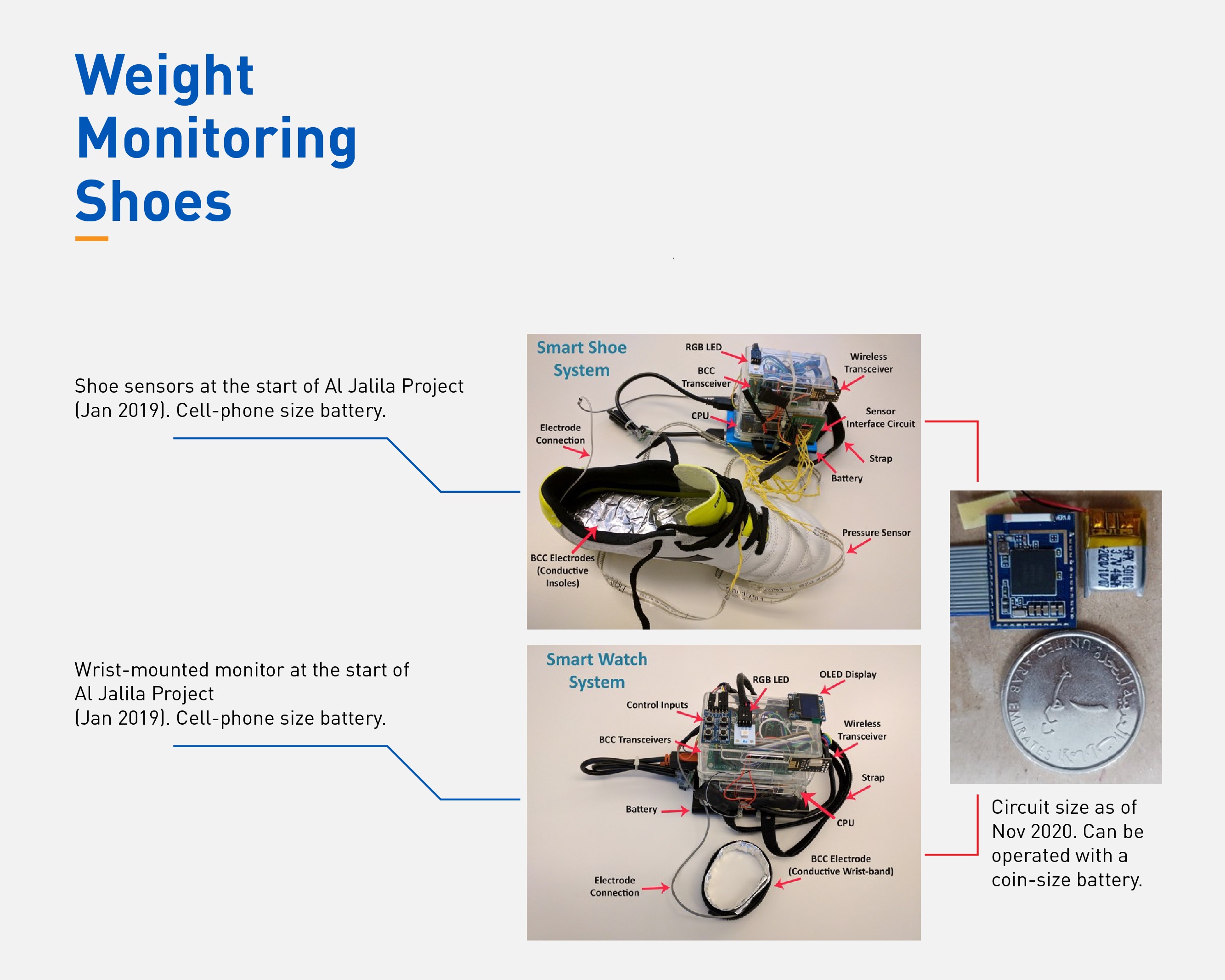
Short-term changes in body weight are correlated with some severe health problems and daily information about a patient’s body weight could save lives.
Dr. Ibrahim Elfadel, Professor of Electrical Engineering and Computer Science, and Dr. Shahzad Muzaffar, Postdoctoral Researcher, were recently awarded an Al Jalila Foundation research grant for their work on sensors integrated into shoes to continually monitor body weight. The Al Jalila Foundation is a not-for-profit organization dedicated to transforming lives through medical research, education and treatment in the UAE. The researchers were recently granted a US patent to cover their innovative sensing method. Technical details on their sensor design appeared in the IEEE Sensors Journal in July 2020.
Their work combines pedobarography with wearable technology, using sensors embedded in shoes for continuous and unintrusive body weight monitoring.
“Pedobarography is the art of measuring and analyzing pressure forces exercised by the foot on the ground during the walk cycle,” explained Dr. Elfadel. “Wearable pedobarography is a highly promising research area and the results are expected to impact a range of healthcare applications such as activity monitoring, weight estimation, obesity control, prosthetics and sports medicine. Other engineering areas can also profit from wearable pedobarography, including robotics, security, and entertainment.”
Many elements of healthcare require a careful look at body weight over time but short-term changes are correlated with severe physical, mental and emotional health problems. For example, the American Heart Association considers a sudden weight gain of more than 2 to 3lbs in a 24-hour period a medical alert, with this supported by medical studies finding sudden increases in body weight are associated with hospitalization for congestive heart failure. These studies report that daily information about a patient’s body weight could alert clinicians to patients who may be at high risk for hospitalization on the basis of weight gain.
Existing commercially available shoes with sensors include those used for athletic performance monitoring, training and health analytics. Commonly, the shoe insole is where the pressure sensors are integrated, making them more suitable for gait and activity monitoring but much less suitable for ground reaction force, and therefore, body weight measurements.
“To help prevent heart failure hospitalization, it’s crucial to enable monitoring technologies that can detect such body weight changes early enough for preventive measures to work,” explained Dr. Elfadel. “Continuous monitoring of body weight requires continuous measuring of ground reaction forces under the feet. Traditionally, force sensors are placed flat in a shoe insole, and the data is collected for further analysis. Unfortunately, the traditional sensor placement fails to account for the total applied force due to a spreading effect within the shoe insole. Placing the force sensors at only few points under the flat insole makes it impossible to account for the total reaction force.”
The ground reaction force is the force exerted by the ground on a body in contact with it. A person standing motionless on the ground exerts a contact force on it equal to the person’s weight, while an equal and opposite ground reaction force is exerted by the ground on the person. Measuring this accurately, however, is a major challenge. In existing designs, Force Sensitive Resistor (FSR) sensors have been placed into the insole, but since these only capture some of the total ground reaction force, the weight estimations are subject to significant errors, especially when the patient is moving.
Dr. Muzaffar and Dr. Elfadel used a novel approach to shoe-integrated sensor design and characterization to ensure accurate continuous body weight measurements, while also keeping the shoe as comfortable and ordinary as possible. Rather than integrating the FSRs in the insole, the team used them on the external frame of the shoe. They designed an integrated three-layer structure that consolidates the reaction force exerted by the ground, channeling the total applied force to a set of carefully placed points under the shoe to improve accuracy. To complement the sensor, the team also developed a high-performance processing methodology to optimize sensor geometry and integrate it seamlessly with shoe design.
“We used a layered structure called Sandwiched Sensor Force Consolidators (SSFC) under the shoe sole to concentrate and channel the applied forces,” explained Dr. Muzaffar. “Each SSFC is a three-layer structure made of top and bottom capping layers and a middle sensory layer. The SSFC can be shaped to an ergonomic shoe design that is comfortable to wear. Plus, our sensor array mitigates the ‘spreading out’ effect of the total ground reaction force. The main idea was to concentrate the applied forces on a set of critical points placed under the shoe sole, hence the SSFC. The number and shapes of the SSFCs can be customized for comfort and force sensing accuracy.”
Importantly, this novel approach can be used when the wearer is walking, not just when they are standing still. In addition to the SSFC, innovative signal processing algorithms have been used to recover the body weight from the waveforms of the ground reaction forces during the walk cycle. As a result, the measurements collected from the prototype developed at Khalifa University were shown to be more than 99 percent accurate, even in the presence of motion. This is at least four times better than the existing state-of-the-art products. Additionally, the sensor array and integration technique can enable more precise measurement methods for several adjacent applications to body weight monitoring, including gait analysis, sports medicine, and physical therapy.
Jade Sterling
Science Writer
23 March 2021






